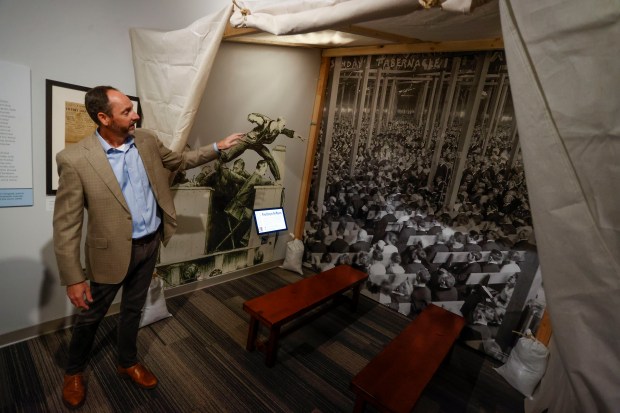
TAMPA — The two 1920s-era bathing suits consisting of black tank tops and thigh-high shorts on display at the Tampa Bay History Center were worn by women, curator Brad Massey initially believed. No, men, he later figured. Maybe both?
“We catalogued them as women’s,” Massey said. “But we recently talked to a fashion historian who is convinced one is a men’s suit … The other could have been unisex. A lot of the suits then were androgynous.”
The 1920s are described as roaring, but there was little skin at the beach, the most risqué dance was the foxtrot, and, while liquor — or hooch as it was called back then — was bountiful, one sip put you on the wrong side of the law.
So, is roaring accurate?
Absolutely, Massey said, when compared to the previous Victorian generation. “They were rebelling against the more conservative environments that they grew up with.”

That story is told through the history center’s new exhibit, “Decade of Change: Florida in the 1920s.” It features the music of the time as well as displays about prohibition, Pentecostalism and those sexy androgynous bathing suits.
To understand why shorts and tank tops as beachwear were considered provocative, look to the style from a few years earlier, which sometimes included sleeves.
“In 1917, anything that was two inches above the knee basically defied regulations by the American Association of Park Superintendents,” Massey said. “At some beaches, the police would come and get you.”The younger generation pushed back with less fabric covering their bodies. Men still hid their chests behind tank tops, but women dared to show more leg.
“When everyone was dressed on the beach like that, it became normal,” Massey said, “and there wasn’t much the decency police could do.”
Inspired by the new jazz music hitting the scene, women’s nightlife fashion changed, too.

While the foxtrot seems tame by today’s standards, the upbeat dance music with horns was radical for the 1920s. The old Victorian-style gowns were not conducive for those who wanted to cut a rug. So those were replaced with ballroom gowns, or “glad rags,” as the exhibit calls them.
“If you look at the ballroom attire of the 1920s,” Massey said, “it’s not much different than it is today.”
The history center has an interactive exhibit with dance steps to teach the foxtrot to visitors, but don’t let 1920s-era Pentecostals see you practicing the devil’s steps.
The growth of the Pentecostal movement in the 1920s and their tent revivals was, in part, in reaction to the rebellious ways of that decade, Massey said. By 1926, Florida had over 500,000 Pentecostal church members.
“Holy Rollers … argued that all the historical teachings told in the Bible were accurate,” reads a placard in the exhibit hanging near a model of the type of tents used for worship centers throughout the country. “Many also abstained from drinking alcohol, dancing, going to the movies and engaging in other popular modern amusements.”

But they couldn’t keep nonbelievers from those amusements, especially alcohol, nor could the state and federal governments.
“Florida goes dry early. By 1904, there are 26 dry counties,” Massey said. “Then in 1915, we outlaw saloons. Hillsborough is one of the few counties that is still wet at the time of statewide prohibition in 1919, a year before nationwide prohibition.”
The Tampa Bay area didn’t seem to care. Speakeasies replaced bars and moonshiners in the rural areas delivered the illegal alcohol in jugs, some of which are on display at the history center.
“And a lot of booze that comes to Florida gets smuggled from the Bahamas,” Massey said. “The year prohibition goes into effect, the imports of liquor to the Bahamas increased by 20 times … It’s not as if the Bahamian people decided that they’re going to start hammering down drinks. Almost all of that ends up in Florida.”




